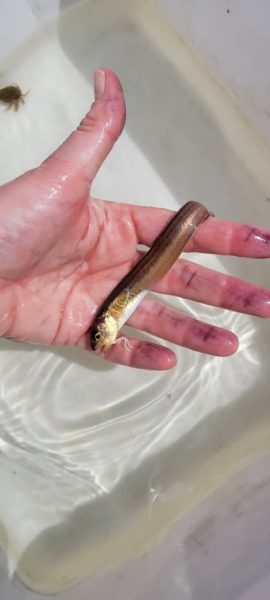Coastal Restoration Program Update
July 21, 2022October 12, 2022
The 2022 season was one of our busiest and most productive yet. Over 4.5 million oyster larvae were set on oyster castles in our aquaculture tanks, resulting in an additional 250 oyster castles planted at the living shoreline site at Naval Weapons Station Earle (NWSE). The setting rate was 30% – one of the highest rates we’ve had yet. We also continued our monitoring and research on biodiversity and habitat value, sedimentation, oyster growth and mortality, and overall integrity of the living shoreline site. We officially kicked off Phase 2 of the NFWF funded Nature-Based Features project that will result in final designs and permits for resilience work at NWSE. We are happy to announce the Coastal Restoration Program secured another grant from NJDEP to continue the expansion and research at the living shoreline. A few monitoring days are left before the water turns too cold for our dive team to be in. Late fall and winter we will head into the lab to analyze sediment samples.
We continued to strengthen our partnerships with NWSE, Congressman Pallone, Biohabitats, Rutgers University, Monmouth University, and Ohmsett and look forward to advancing restoration and resilience projects along the Raritan Bayshore and at NWSE.
On August 16th we celebrated our 10th year at Earle by christening our new and improved aquaculture facility. We were honored to have Captain Callahan, the Commander at NWSE, join us for the celebration. Check out Brian Donohue’s coverage of the event here.
On October 6th , Coastal Restoration Program Director Meredith Comi presented at the NSBPA Northeast Coastal Conference: “Hurricane Sandy – 10 Years Later.”
Thank you Ohmsett and NWSE for all of your support and help in making this work possible. A special thanks to our dedicated volunteers, both in and out of the water: Michael Krug, Derek Noah, Hailey Jones, Connor Kennedy, Jim Scarcella, Dennis McNamara , Dan Carroll, Sid Arguello, and Clay Halvorsen.
August 10, 2022
Our oyster babies have attached to the oyster castles and have made their way to their permanent home at the Naval Weapons Station Earle living shoreline. The castles are installed using vessels and SCUBA, hand placing the castles on the bay bottom. The Team also completed the first fish trap deployment in July. To study habitat value of the living shoreline, fish traps are left to soak for 48 hours. All species are identified and then released. We saw something new this round, a Cusk Eel! We also deployed the first round of sediment traps. Sediment traps are installed at the living shoreline and provide us with data on how much accretion is in and around the oyster castles at the living shoreline – valuable information for determining the efficacy of resilience projects. We also monitored the SOAR oysters that were planted last year from G.E.I Oyster Farm in the Great Egg Harbor Inlet. These oysters are huge and beautiful and are hopefully be reproducing, adding more oysters to the Raritan Bay system. Lastly, we worked with Central Regional High School’s hockey team to put together oyster reef structures made from donated hockey sticks. Check out the article here!
July 21, 2022
It’s been a very busy few weeks for the Coastal Restoration team at Naval Weapons Station Earle!

